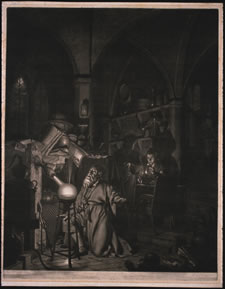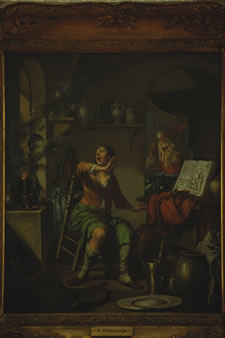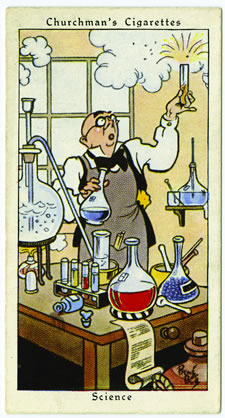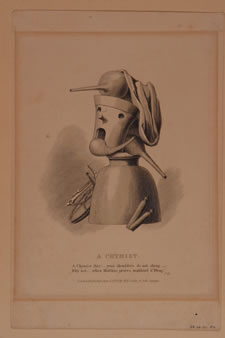|
|
Vol.
32 No. 3
May-June 2010
Marvels & Ciphers: A New Exhibit at Chemical Heritage Foundation Links Alchemy and Quantum Chemistry
by CHF staff
 |
|
| Rudolph Pariser in front of a blackboard with quantum calculations, contemplating a molecular model, 1950s. Courtesy of The Hagley Museum and Library. |
|
For centuries, with means ranging from alchemy to quantum-enabled technologies, scientists have struggled to understand the material world—with varying degrees of success. Public responses to scientific debate and discovery are even more varied. A single breakthrough can elicit fascination and hope as well as anxiety and fear. With paintings, photographs, books, and cartoons, Marvels & Ciphers—a new exhibit at the Hach Gallery of the Chemical Heritage Foundation—explores the inevitable social complexity of scientific pursuits.
The Discovery of Phosphorus, 1775
William Pether (1738–1821). After the
painting by Joseph Wright of Derby
(1734–1797). Mezzotint.
Gift of Fisher Scientific International, CHF Collections.
|
 |
| The mysterious cold glow of phosphorus, the secrecy and excitement surrounding its discovery by Hennig Brand in 1669, the awe of those witnessing Brand’s demonstrations, and the ensuing frustrated desire of other chemists to possess Brand’s secret encapsulate the types of complex dynamics that can surround new knowledge. The newly discovered element was not understood or yet practical. But it fulfilled a well-known requirement of the philosophers’ stone, being made from low or despised matter (human urine). The event could only capture and inflame imaginations and, as the image demonstrates, might be viewed as a divine gift. |
Visitors to Marvels & Ciphers are understandably surprised to find alchemy and quantum chemistry woven together in one exhibit. After all, the differences are obvious. At the most basic level, quantum chemistry works, alchemy does not. Alchemy was built on the authority of ancient and often flawed observation and conjecture and persisted long after it had shown no results. Quantum chemistry defied the most up-to-date theories of matter and proved to be true despite being beyond comprehension without models and metaphor. Yet to the public at large for most of recorded history, the differences between quantum chemistry and alchemy are smaller than they would appear from inside the world of chemistry.
Throughout the centuries experimenters have heated and cooled matter, mixed and distilled it, and subjected it to every process imaginable. The results have often dismayed or dazzled even the scientists, let alone the uninitiated. And as empirical knowledge grows, explanations for these phenomena are born, discarded, and rewritten.
In the 20th century the comfortably solid ground laid by the experimental work of generations of scientists became again a strange and surprising world thanks to quantum theories. The mathematics of uncertainty and probability that supports the platform driving our modern technologies is “insider knowledge” as wondrous and unfathomable as the alchemists’ fabled philosophers’ stone. From alchemical times to our current quantum-enabled century, science has given us marvels to wonder at and ciphers to decode.
The Theory Changes—The Struggle to Understand Continues
A tension exists between the minutiae of what is observed, discovered, or recorded and whatever big idea has been proposed that brings meaning and gives context to the data. Knowledge expands only after results from studies and experiments accumulate and challenge what is already “known.”
The investigator may have an intense relationship with what is investigated. A sort of intimacy develops between the observer and the observed, an intimacy vicariously felt by the bystander. With the introduction of modern instruments, observation has become indirect. But with familiar bridging vocabularies to interpret data, users can experience the instruments as extensions of their own senses. Disconcertingly, however, when making observations at the atomic level, the observer interferes with the data gathering.
The observer wants to make sense of the data. Describing what is seen and developing a consistent language for communicating it to others has been a centuries-long struggle for natural philosophers and science investigators of all types.
The first tools for data gathering were the investigator’s senses: eyes, ears, nose, mouth, and hands. They are still valuable. But when words and senses are inadequate, tools for communicating become ciphers to the uninitiated: symbols and mathematics, metaphor and allegory. An insider and outsider dynamic is created.
 |
The Alchemist’s Experiment Takes Fire, 1687. Hendrick Heerschop (1620–1690). Oil on canvas.
Gift of Fisher Scientific International, CHF Collections.
The alchemist genre contained a certain flavor of humorous ridicule that delighted 17th-century Dutch society. Genre paintings often show family life intertwined with work. The paintings of alchemists in their workshops put in play puns, traditional sayings, aphorisms, and symbols. We see very few depictions of explosions, although they must have been common since alchemists often heated materials in fragile glassware. The explosion shown here is a scene of failure. The disaster is paired with the alchemist’s wife wiping the baby’s bottom, which puns on the archaic Dutch usage where algemist (alchemist) can also mean “all is lost,” and by extension, “all is crap.” Sadly, the alchemist’s failures may be ongoing, as is the necessity of the mother to continually wipe her baby’s bottom. |
The Alchemist
Symbolic language, metaphor, and allusion helped preserve secrecy and convey the multiple layers of meaning that infused early modern thinking. Alchemists did, in fact, observe remarkable things, observations that would give them hope that they were on the right track in their search both to understand the mysteries of matter and to prepare the philosophers’ stone. Likewise, there is evidence that some alchemical imagery was not artistic invention but instead reflects what alchemists actually observed.
“Envision knowledge based on practical experience and then infuse this understanding with symbolic imagery and you may have made space for alchemical thinking. Add a dollop of music and poetry and you may be ready to enter a doorway into the mind of an alchemist.”
—Lawrence Principe
The Quantum Chemist
The quantum chemist, like the alchemist, had practical goals: to create meaningful ways to think about the surprising behavior of elementary particles. Chemists, physicists, and mathematicians, enabled by the ever-more-powerful computer, were able to frame and answer questions that led to some of our most basic everyday technologies. The laws of physics when applied to chemistry can be used for simple applications: for example, the hydrogen atom has one proton and one electron. But the mathematical calculations become impossible to do for the hundreds of particles in a typical molecule.
In 1951, DuPont’s Jackson Laboratory had a problem. New synthetic fibers were being developed and new principles for dye selection needed to be created. Rudolph Pariser, who had just joined Jackson Laboratory, wondered whether applying quantum chemistry could hold an answer to the color of dyes. He contacted Robert Parr, an expert in quantum chemistry, and together they developed a new theoretical method, the P-P method (later developed into the Pariser-Parr-Pople method). Using a brand-new state-of-the-art IBM 701 computer, Pariser was then able to calculate the color of complex molecules such as dyes.
Thus, with the advent of the computer, clever approximation techniques, like the Pariser-Parr-Pople method, expanded practical applications of quantum chemistry and were early “proof” that quantum mechanics led to realistic predictions of molecular energies and shapes.
 |
“Science” trading card, early 20th century. Churchman’s Cigarettes, Imperial Tobacco Company. Gift of William Helfand,
CHF Collections. |
Public Perceptions
In the 17th century, the alchemists actually were making advances in chemistry even when their theoretical base was wrong. By developing experimental methods, the alchemists made improvements in the lab that led to modern chemistry and even atomic theory. But in the popular mind of the time, alchemists were charlatans or worse. The painting The Alchemist Takes Fire makes this view very clear. Many other paintings in this popular 17th-century genre of art have similar themes showing the low place of the alchemist in European society.
Alchemists were also part of daily life in cities and towns. They were barbers, surgeons, dentists, dispensers of medicines of questionable value, and otherwise subjects of scorn and satire in their communities. Quantum chemists, on the other hand, are as mysterious as their work to most people in modern culture. They are remote from the daily life of any community outside a lab or research facility. Their work defies image making, but does lead to occasional jokes—a brand of humor that requires some level of scientific training to understand:
A policeman stops Heisenberg for speeding, and the cop asks: “Sir, do you have any idea how fast you were driving?”
“No,” replies Heisenberg, “but I know where I am!”
Heisenberg is lost and asks a policeman, “Where am I?” to which the intergalactic traveler in the disguise of a cop answers, “I don’t know, but I know where you are headed.”
Q: Why was Heisenberg bad in bed?
A: Because when he had the time, he didn’t have the energy, and when he had the position, he didn’t have the momentum.
Two atoms are walking along when one of them trips and lands on the floor.
“Are you all right?” inquires the first.
“No!” replies the second, “I’ve lost an electron!”
“Are you sure?” asks the first.
“Yes, I’m positive!” answers the
second.
So Different, Yet Similar
“We must be clear that when it comes to atoms, language can be used only as in poetry. The poet, too, is not nearly so concerned with describing facts as with creating images and establishing mental
connections.”
—Niels Bohr to
Werner Heisenberg, 1920
 |
A Chymist, 1 June 1829. W.B. Cooke. Etching.
Gift of Fisher Scientific International, CHF Collections.
Photograph by Gregory Tobias. |
Both the alchemist and the quantum chemist relied on symbol to communicate what was beyond their abilities to observe. For the alchemists, working with just five senses and a flawed theory of matter, it is amazing how much they contributed to the understanding of the world around us. We hear more about alchemy’s failed attempts to transmute lead into gold than about its pragmatic achievements, such as making medicines, glass, perfumes, and gunpowder; refining metals and making alloys; making pigments and dyes; and learning to separate and isolate various chemicals. Individuals investigated basic questions like the phenomenon of colors created by prisms or the chemical nature of the body’s organs.
Visit CHF or Visit Online
Linking the world of alchemy and quantum chemistry brought together many parts of the collections and library resources at CHF in an exhibit expressly designed for its museum space. Marvels & Ciphers will be open for the rest of 2010 for those who might be traveling to Philadelphia during this year. For those who cannot travel to Philadelphia this year, visit the exhibit online.
www.chemheritage.org
Page last modified 12 May 2010.
Copyright © 2003-2010 International Union of
Pure and Applied Chemistry.
Questions regarding the
website, please contact [email protected]
|